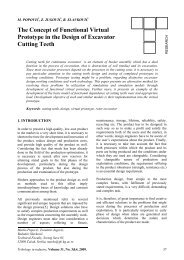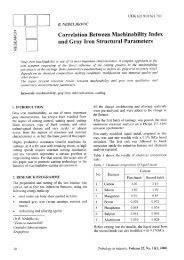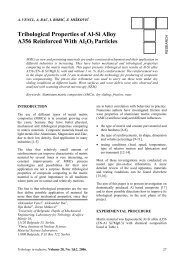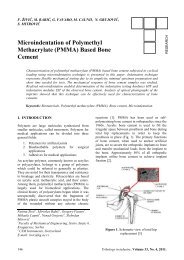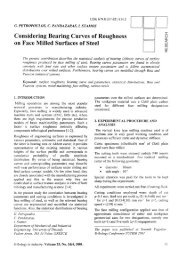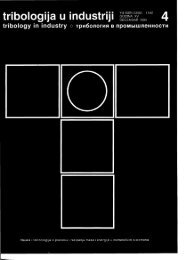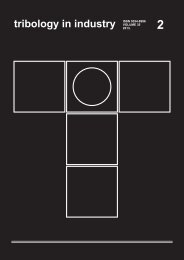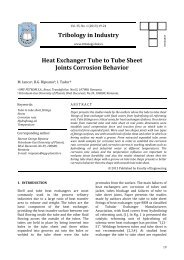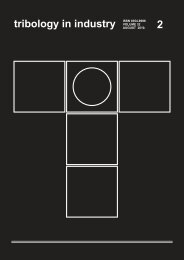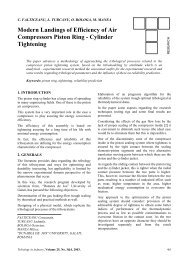Tribological Behavior of Thermal Spray Coatings, Deposited by ...
Tribological Behavior of Thermal Spray Coatings, Deposited by ...
Tribological Behavior of Thermal Spray Coatings, Deposited by ...
You also want an ePaper? Increase the reach of your titles
YUMPU automatically turns print PDFs into web optimized ePapers that Google loves.
A. Lanzutti at al., Tribology in Industry Vol. 35, No. 2 (2013) 113‐122strength <strong>of</strong> material. The carbides are mainlyproduced <strong>by</strong> Cr and Mo. The hardness <strong>of</strong> thematerial is about 180±20 HV 0,3 and the ferriticgrain size is about 45±15 µm.c)Fig. 2. SEM images and microstructuralcharacterization <strong>of</strong> thermal spray coatings: a) NiCr80/20, b) WC CoCr 18/4 and c) NiCr 80/20+ Cr 2 O 3 .Fig. 1. Microstructure <strong>of</strong> gr. 22 steel.In Fig. 2 are shown the SEM micrographsobtained for <strong>Thermal</strong> spray coatings and therelative data acquired <strong>by</strong> mechanicalcharacterization and image analysis. In Tab. 3the thermal spray coatings’ properties are listed.a)b)Table 3. Results <strong>of</strong> thermal spray coatings’characterization.Coating Thickness Porosity Hardness HV0,3[µm] vol.%NiCr 98±16 6.5 359±18WCCoCr 105±15 3.45 1027±21NiCr+Cr2O3 (38+187) ± 25 5.5+10.1 (341+1118) ±24As can be observed, the three types <strong>of</strong> thermalspray coatings present different thickness andporosity. The porosity, acquired <strong>by</strong> imageanalysis, is higher for the coatings deposited <strong>by</strong>APS technique compared to the HVOF deposits.This difference could be related to both powderssize and impact velocity that is lower in APStechnique with respect to HVOF. Indeed, thedifference in kinetic energy <strong>of</strong> the moltenpowders, that is higher in HVOF technique, leadsto a different density on deposited coating. Thehardness acquired is associated to the materialdeposited and the values acquired are similar todata available in scientific literature for thermalspray coatings [1‐13].The SEM micrographs obtained on cross section<strong>of</strong> Ni/SiC composite coatings previously etched(acetic acid: nitric acid 1:1) are shown in Fig. 3.In Table 4 are listed the electrodepositedcoatings’ properties.Table 4. A result <strong>of</strong> Ni/SiC electrodepositscharacterization.Coating Thickness[µm]SiC wt.% HardnessHV0.3Ni 78±7 ‐ 172±7Ni/µSiC 73±8 0.8 247±8Ni/nSiC 75 ± 5 0.15 270 ±9116



